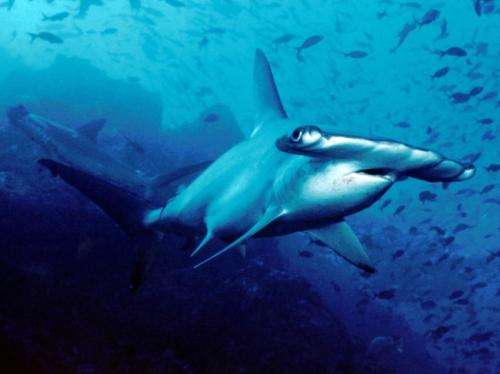This is a common scalloped hammerhead shark, Sphyrna lewini. Credit: Wikimedia Commons, photo by Barry Peters
The bull shark, a fearsome predator that could kill you with a single bite, turns out to be the fourth-most abundant shark species in South Florida, according to a new study of the region's sharks.
Fortunately, bull sharks find us pretty unappetizing, considering how many are out there and how rarely they bite anyone.
"This is a formidable predator that could pose a risk to humans," said Neil Hammerschlag, research associate professor, Shark Research and Conservation Program at the University of Miami Rosenstiel School of Marine & Atmospheric Science, and co-author of the study. "But with the number of people that use the ocean off Miami for recreation, it just shows these animals are not out to hurt humans. Humans are obviously not on the menu."
The study, which will appear in the scientific journal Ocean & Coastal Management, examined 3,398 sharks caught and released off Miami and the Florida Keys from 2009 to 2021. They ranged in size from a 20-inch Atlantic sharpnose shark to a 14-foot, 7-inch great hammerhead. Of the 15 species identified, the most common by far was the nurse shark, followed by the blacktip, lemon and bull shark.
The study was intended to establish a baseline for the status of South Florida's sharks—which species were there, in what abundance, where were they located, at what times of the year, and so on.
Shark populations have dropped worldwide from overfishing, driven by the demand for their meat and fins. They also get caught accidentally in nets and on longlines of fishing boats going after swordfish, tuna and other species.
With this study's data in hand, scientists will be able to monitor the region's shark populations for changes that could call for altering rules on fishing and water pollution.
"This study is the first and only population assessment of large coastal sharks published to date in Miami and the Upper Keys," said Abigail Tinari, a master of science student at Rosenstiel and lead author of the study.
"It lets us know what's here, and that can be compared in the future to know how these species are doing," she said. "It gives you an idea of what areas the sharks are using and the current number and abundance of the sharks, so they can be compared for future studies and future management."
The study counted 1,335 nurse sharks, 650 blacktips, 314 lemon sharks and 253 bull sharks.
Bull sharks are among the most dangerous sharks, even if attacks remain rare. Robust animals that tend to be wider and heavier than sharks of comparable length, bull sharks accounted for about 18% of the 868 known unprovoked attacks in Florida since 1882, according to the International Shark Attack File, based at the University of Florida.
"The white, tiger and bull sharks are the 'Big Three' in the shark attack world because they are large species that are capable of inflicting serious injuries to a victim, are commonly found in areas where humans enter the water, and have teeth designed to shear rather than hold," the International Shark Attack File's web page states.
The other two species species in the Big Three showed up off Florida, but in smaller numbers. The survey found 100 tiger sharks, ranging in size from 3 1/2 feet to 13 feet. The survey identified a single great white about 11 feet long.
But even accounting for 18% of bites, the number is still low, considering the opportunities to the sharks presented by the millions of swimmers in Florida waters.
Last year saw 16 shark bites in Florida, far below the five-year average of 30. The risk of death in a shark's jaws remains so low that scientists are fond of comparing it to more likely ways of dying, such as a fireworks accident, where a fatal accident is 11 times more likely than a fatal shark attack, or a lightning strike, which is 47 times more likely, according to the International Shark Attack File.
Unlike several other large shark species, Hammerschlag said, bull sharks come close to beaches, where they generally ignore swimmers.
"It's amazing to me that we catch these massive bull sharks relatively close to shore," Hammerschlag said. "It's just amazing that we coexist with them."
A surprise finding in the study was the abundance of great hammerheads, sharks that have suffered severe declines from the fin trade and from their relatively fragility, since they often die after being released from fishing gear.
The study found 238, making them the fifth-most abundant species.
"They're globally endangered," Hammerschlag said. "They've undergone very large declines. But off Miami, it's one of the more common species."
Here are the numbers for the other species identified in the study: 210 sandbar sharks, 178 blacknose sharks, 67 Atlantic sharpnose sharks, 22 scalloped hammerhead sharks, 13 Caribbean reef sharks, 11 bonnethead sharks, five dusky sharks and one spinner shark.
©2021 South Florida Sun-Sentinel. Distributed by Tribune Content Agency, LLC.
























